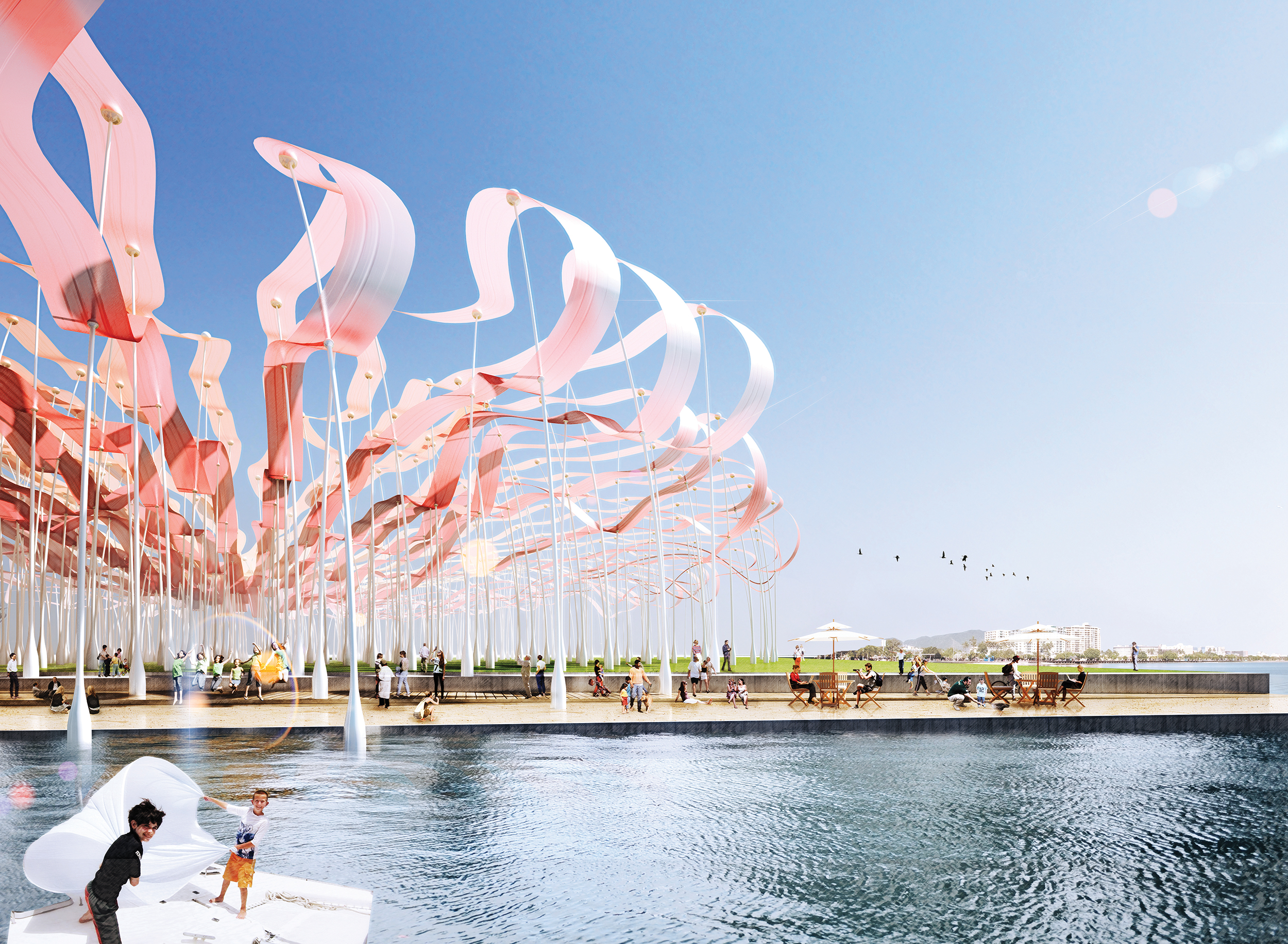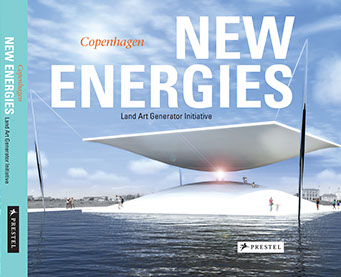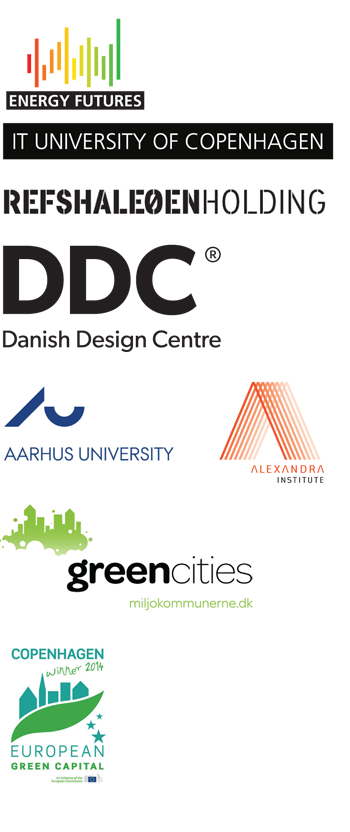LAGI 2014
Copenhagen




































Solar Hourglass
1st Place Winner LAGI 2014 Copenhagen
Santiago Muros Cortés
Energy Technologies: concentrated solar power (thermal beam-down tower with heliostats)
Annual Capacity: 7,500 MWh
Quiver
2nd Place Winner, LAGI 2014 Copenhagen
Mateusz Góra, Agata Gryszkiewicz
Energy Technologies: biofuel, aeroelastic flutter (WindbeltTM)
Annual Capacity: 550 MWh (223 MWh bio,
327 MWh WindbeltTM)
eMotions: Energy Motions and Art Emotions
3rd Place Winner LAGI 2014 Copenhagen
Antonio Maccà, Flavio Masi
Energy Technologies: photovoltaic panels, micro-scale vertical axis wind turbines (VAWT) and horizontal axis wind turbines (HAWT), stacked ceramic multilayer actuators, piezoelectric wind energy systems
Annual Capacity: 2,000 MWh
Energy Duck
a submission to LAGI 2014 Copenhagen
Hareth Pochee, Adam Khan, Louis Leger, Patrick Fryer
Energy Technologies: photovoltaic panels, hydraulic turbines
Annual Capacity: 400 MWh
Beyond the Wave
a submission to LAGI 2014 Copenhagen
Jaesik Lim, Ahyoung Lee, Sunpil Choi, Dohyoung Kim, Hoeyoung Jung, Jaeyeol Kim, Hansaem Kim (Heerim Architects & Planners)
Energy Technologies: organic thin film
Annual Capacity: 4,229 MWh
GRID Slide
a submission to LAGI 2014 Copenhagen
Morten Rask Madsen, Julie Trier Brøgger, Julie Rindung, Natalia Guerrero Gutiérrez, Artis Kurps, Kevin Bailey, Søren Laurentius Nielsen, Per Møller, Jesper Ahrenfeldt, Tobias Thomsen
Energy Technologies: algae biofuel
Annual Capacity: 100,000 MWh
Windshape
a submission to LAGI 2014 Copenhagen
Manon Robert, Martin Le Carboulec, Marc Antoine Galup
Energy Technologies: piezoelectric fabric, rotating electromagnetic generators
Annual Capacity: 750 MWh
Echo of Wind
a submission to LAGI 2014 Copenhagen
Mathias Bank Stigsen, Olga Krukovskaya
Energy Technology: elastomeric piezoelectric toroids
Annual Capacity: 700 MWh
Golden Roots
a submission to LAGI 2014 Copenhagen
Ronny Zschörper, Franziska Adler
Energy Technologies: biomass, piezoelectric paving
Annual Capacity: 52 MWh
Balance / Imbalance
a submission to LAGI 2014 Copenhagen
Hideaki Nishimura
Energy Technologies: Buoy-type wave converter with Electroactive Polymer Artificial Muscle, Sphelar® photovoltaic, piezoelectric films
Annual Capacity: 720 MWh
Onshore Power
a submission to LAGI 2014 Copenhagen
Han Bao, Feng Xu
Energy Technologies: wind-driven hydraulic cylinder generators
Annual Capacity: 3,500 MWh
Regatta Fields
a submission to LAGI 2014 Copenhagen
Riccardo Mariano, Salvatore Maraniello
Energy Technologies: vertical axis wind turbines, Pavegen™ pavers
Annual Capacity: 500 MWh
Oscillating Platforms
a submission to LAGI 2014 Copenhagen
Felix Cheong
Energy Technologies: wind sails, oscillating water column, Wells turbine
Annual Capacity: 34,000 MWh
A Place for a Chocolate Ice Cream
a submission to LAGI 2014 Copenhagen
Juan David Ramirez, Diana Marcela Manrique, Bao Bao Huan, Rasmus Johansen
Energy Technologies: photovoltaic panels
Annual Capacity: 3,500 MWh
Sail
a submission to LAGI 2014 Copenhagen
Andrew Jepson-Sullivan, Grayson Morris
Energy Technologies: aeroelastic flutter (WindbeltTM)
Annual Capacity: 603 MWh
Stone Wave
a submission to LAGI 2014 Copenhagen
Nicolas Violette, Christofer Cornevaux
Energy Technologies: hydraulic cylinder microturbine generators
Annual Capacity: 60 MWh
Super Cloud
a submission to LAGI 2014 Copenhagen
Lucas Jarry, Rita Serra e Silva, Lucas Guyon, Marianne Ullmann
Energy Technologies: piezoelectric discs
Annual Capacity: 2,487 MWh
The Cloud
a submission to LAGI 2014 Copenhagen
Tim Thikaj
Energy Technologies: wind microturbines
Annual Capacity: 2,016 MWh
LAGI 2014
site typology: brownfield
LAGI 2014 was an ideas competition to design a site-specific public artwork that, in addition to its conceptual beauty, has the ability to harness energy cleanly from nature and convert it into electricity for the utility grid.
LAGI 2014 came to Copenhagen at an opportune moment. As the city (the European Green Capital of 2014) moves towards carbon neutral status by 2025 the debate over the aesthetic manifestation and human interaction component of our new energy infrastructure is becoming increasingly important to the planning strategies required to attain zero-carbon sustainability goals.
Design Brief
Follow this link to find the >
LAGI 2014 Design Brief Document
Publication
New Energies, Prestel Publishing
Purchase >
The LAGI 2014 design site—Refshaleøen—at its height, was a shipyard that employed 8,000 individuals and is poised to be an important area for new development within the city. The rich historical context of the site, and its place in Copenhagen’s future informed the design proposals.
The view to the site from the Langelinie and the cherished statue of the Little Mermaid provided a beautiful canvas on which to create.
LAGI 2014 partnered with the Green Cities Municipalities (including Albertslund, Herning, Allerød, and Kolding) of Denmark for additional opportunities for teams, which were outlined more in depth in the Design Guidelines.
The award ceremony, exhibition, and book launch was held in Copenhagen in the fall of 2014 in partnership with the Danish Design Centre at the Design Society.
Various community events were held in Denmark in collaboration with project partners and we worked again with Prestel publishing to create a beautiful publication that includes 60 of the top submissions, along with essays by leaders in the fields of architecture, art, renewable energy, urban planning, and more.
LAGI 2014 Supporters
Region Hovedstaden
The Culture and Leisure Committee
for the City of Copenhagen
Dreyers Fond
LAGI 2014 Partners
IT University of Copenhagen
The IT University of Copenhagen is an independent educational and research institution, dedicated to the digital world. The university works to make Denmark exceptionally good at making value through IT by providing contemporary study programs and research at the highest academic level. At the IT University LAGI is positioned in the research group Energy Futures. Energy Futures is a network of computer scientists, software engineers, interaction designers, media and communication scholars and social scientists focused on prototyping together a range of possible fossil-free energy futures. The research activities are positioned at the boundary between the technical, design, social and business aspects of IT and energy.
http://www.itu.dk/
http://energyfutures.itu.dk/
Refshaleøen Holding
Refshaleøen is an island in Copenhagen’s harbor, which until 1996 housed the shipyard Burmeister & Wain. At its height, the shipyard employed 8,000 employees, and appears as an icon of Danish industrial history. A portion of the island was reclaimed in the 1870s when the port’s waterways were made deeper.
The many shipyard workers today have been replaced with a mixture of creative entrepreneurs, small craft, flea markets, storage facilities, and cultural and recreational uses.
Danish Design Centre
The Danish Design Centre is an independent, government-funded organization established in 1978. DDC’s focus in relation to the design community and business sector is on collecting, communicating and testing knowledge about the main factors that influence design and how design can continue to be a driver for innovation and growth in the future. The DDC is working with these topics in close cooperation with designers, partners, sponsors, businesses and audiences both nationally and internationally. The aim is to strengthen society’s capacity through design and—in a contemporary way—to carry on, enhance and renew the Danish design tradition. The DDC’s mantra is “design that makes sense”, and its key knowledge areas are new materials, new technology, and big data.
Information Studies at Aarhus University
Alexandra Institute
Alexandra Institute creates IT-based products and services that generate social value and contribute to economic growth. Alexandra Institute's work responds to issues of social relevance—primarily the needs of businesses and organisations to get access to the latest research results—with the aim of creating research-based user-driven innovations. Alexandra Institute is one of Denmark’s nine members of GTS - Advanced Technology Group, a network of independent Danish research and technology organisations. Its primary focus is pervasive computing, i.e. ICT embedded into products and surroundings. They offer Denmark's strongest and most comprehensive competences within the development and application of pervasive computing technologies.
Green Cities
Green Cities – for Municipalities and the Environment is a visionary and binding partnership agreement between member municipalities that work to ensure sustainability and to make an extra effort to preserve the environment. The municipalities of Albertslund, Ballerup and Copenhagen initiated the partnership in 2000, and Herning, Kolding and Allerød joined later.
Environmental benchmarks are set up for each objective, and the member municipalities are all working towards achieving these objectives. This has helped us in getting closer to realizing our vision of sustainability. In recent years the objectives have been interpreted in a number of different ways, and we now wish to specify and make our environmental profile more stringent.
Shawati' Magazine
Shawati' cares about serving our readers with information that empowers, inspires and creates change as we promote and support the principles and practices of intellectual freedom. Shawati’ is not a podium comprised of fast-paced news blurbs written for the masses; it is an in-depth and timeless visual manuscript comprised of; new innovations and inspirations, creative explorations, insightful interviews, as well as multi-cultural dialogues provoking a global exchange of ideas, additionally we examine each aspect related to life and environment. Moreover it is our aim to offer those outside of our country insight into our culture and national pride - the threads of our identity; thus bridging the gap or ‘shores’ of diversity that unite us under one global village.

Jurors
Connie Hedegaard
European Commissioner for Climate Action
Tina Saaby
City Architect of Copenhagen
Lars Aagaard
Director, Danish Energy Association
Jason F. McLennan
CEO, International Living Future Institute
Nille Juul-Sørensen
CEO, Danish Design Centre
Kent Martinussen
CEO, Danish Architecture Centre
Christian Herskind
CEO, Refshaleøen Holding A/S
Steen Christiansen
Mayor, Albertslund Municipality
Else Marie Bukdahl, Dr. Phil.
Danish Art Historian, Ålborg University
Maria Hørmann
Change Maker—Design & Innovation & Blog Editor—Hello Materials Blog, Danish Design Centre
Stig L. Andersson
Founding Partner, SLA; Creative Director, Professor
Agnete Fog
Chairman of Green Cities 2014–2015
Sharon Chang
CEO and Founder, Yoxi; NYU Trustee
Chris Fremantle
Co-Producer, Public Art Scotland
Matthew Rosenberg
Founding Partner, M-Rad
2nd Place Winner LAGI 2012
Michael Singer
Principal, Artist and Designer, Michael Singer Studio

